THE DIMENSION OF NORMATIVITY IN INFORMAL SOCIAL RELATIONS
Keywords:
social bonds, form of sociation, normativity, phenomenology.Abstract
The aim of this article is to discuss the character of regularities occurring in informal social bonds, be they friendships, romantic partnerships, competitions or rivalries. Since Simmel’s work is emblematic for the theme of social norms involved in durable informal bonds, I take his original concept of forms of association as my point of reference. The argument I propose challenges several of Simmel’s assumptions, namely his objectivist stance, his formal sociology and the autopoiesis of systems of reciprocal effects. Based on this critical rereading of Simmel, I introduce the concept of “socially constructed typical bonds” as a more dynamic and versatile alternative to the static patterns of forms of association. By bringing a subjectivist turn (inspired by Berger, Luckmann and Butler) to Simmel’s forms of association, I argue for the recognition of the blurry, diverse and contradictory understandings of the typical social bond as the ground for relational normativity.
References
Berger, L. Peter and Luckmann Thomas (1966). The Social Construction of Reality, Anchor Books.
Blatterer, Harry (2013). ‘Friendship’s Freedom and Gendered Limits’, European Journal of Social Theory, 16 (4), pp. 435-456.
Blegvad, Mogens (1989). ‘A Simmel Renaissance’ [Review of the book Soziologie und Erkenntnistheorie bei Georg Simmel by Horst Jürgen Helle]. Acta Sociologica, 32 (2), pp. 203-209.
Blumer, Herbert (1969). Symbolic Interactionism: Perspective and Method, Englewood Cliffs, N. J.: Prentice-Hall.
Butler, Judith (1997). Excitable Speech: A Politics of the Performative. New York and London: Routledge.
Cantó-Milà, Natàlia (2005). A Sociological Theory of Value. Georg Simmel's Sociological Relationism. Transcript-Verlag.
Fitzi, Gregor (2002). ‘Comment la société est-elle possible? Développement et signification du ‘paradigme épistémologique’ de la Sociologie de Simmel de 1908’, in L. Deroche-Gurcel und P. Watier (Hg.), La Sociologie de Simmel (1908). Éléments actuels de modélisation sociale, PUF, Paris.
Frisby, David (1992). Simmel and Since. Essays on Georg Simmel’s Social Theory. London and New York: Routledge.
Fuchs, Stephan (1988). ‘The Constitution of Emergent Interaction Orders: A Comment on Rawls’, Sociological Theory, 6(1), pp. 122-124.
Garfinkel, Harold (1967). Studies in Ethnomethodology. New Jersey: Prentice-Hall.
Gilbert, Eric and Karahalios, Karrie (2009). ‘Predicting Tie Strenght With Social Media’, CHI '09 Proceedings of the SIGCHI Conference on Human Factors in Computing Systems, pp. 211-220.
Goffman, Erving (1959). The presentation of the self in everyday life (2nd Ed.). New York, NY: Anchor Books.
Goffman, Erving (1961) Encounters. Indianapolis, Indiana: Bobbs Merrill.
Goffman, Ervin (1967). Interaction Ritual: Essays on Face- to-Face Behavior. Anchor Books.
Goffman, Erving (1983). ‘Presidential Address: The Interaction Order’, American Sociological Review, 48, pp. 1-17.
Granovetter, S. Mark (1973). ‘The Streght of Weak Ties’, American Journal of Sociology, 78 (6), pp. 1360-1380.
Grabowicz, A. Przemyslaw, Ramasco J. José, Moro Esteban, Pujol, M. Josep, Eguiluz, M. Victor, (2012). ‘Social Features of Online Networks: The Strenght of Intermediary Ties in Online Social Media’, PLoS ONE, 7 (1), pp. 1-10.
Habermas, Jürgen (1987). The Theory of Communicative Action, Vol. 2. Boston: Beacon.
Habermas, Jürgen (1996). Between Facts and Norms. Cambridge, MA: MIT Press.
Hochschild, Arlie Russell (1979). ‘Emotion Work, Feeling Rules, and Social Structure’, American Journal of Sociology, 85 (3), pp. 551-575.
Hochschild, Arlie Russell (1983). The Managed Heart. Commercialization of Human Feeling. Berlekey: University of California Press.
Levine, Donald N., Ellwood B. Carter and Eleanor Miller Gorman (1976). ‘Simmel’s Influence on American Sociology I’, American Journal of Sociology, 81 (4), pp. 813-845.
Levine, Donald N. (1981). ‘Sociology's Quest for the Classics: The Case of Simmel’, pp. 60-80 in The Future of the Sociological Classics, edited by Buford Rhea. London: Allen & Unwin.
Levine, Donald N. (1991). ‘Simmel and Parsons Reconsidered’, American Journal of Sociology, 96 (5), pp. 1097-1116.
Luhmann, Niklas (1995). Social Systems. Stanford: Stanford University Press.
Marsden, V. Peter and Campbell E. Karen (1984). ‘Measuring Tie Strenght’, Social Forces, 63 (2), pp. 482-501.
Parsons, Talcott (1966) [1937]. The Structure of Social Action. A Study in Social Theory with Special Reference to a Group of Recent European Writers, New York: The Free Press and London: Collier- Macmillan Ltd.
Poli, Roberto (2010). ‘The Complexity of Self-reference. A Critical Evaluation of Luhmann’s Theory of Social Systems’, Journal of Sociocybernetics, 8 (1), pp. 1-23.
Pyyhtinen, Olli (2010). Simmel and ‘The Social’. Palgrave Macmillan.
Rawls, Anne Warfield (1987). ‘The Interaction Order Sui Genesis: Goffman’s Contribution to Social Theory’, Sociological Theory, 5 (2), pp.136-149.
Rawls, Anne Warfield (1988). ‘Interaction vs. Interaction Order: Reply to Fuchs’, Sociological Theory, 6 (1), pp. 124-129.
Rawls, Anne Warfield (1989). ‘Simmel, Parsons and the Interaction Order’, Sociological Theory, 7 (1), pp. 124-129.
Schütz, Alfred (1967). Phenomenology of the Social Word. Evanston, Illinois: Northwestern University Press.
Simmel. Georg (2009) [1908]. Sociology: Inquiries into the Construction of Social Forms. Vol. I and Vol. II. Anthony J. Blasi, Anton K. Jacobs and Mathew Kanjirathinkal (Eds.& Trans.), Boston: Brill.
Simmel, Georg (1950). The Sociology of Georg Simmel. Kurt H. Wolff (Ed.& Trans.), The Free Press.
Simmel, Georg (1971). On Individuality and Social Forms. Donald N. Levine (Ed.). Chicago and London: The University of Chicago Press, The Heritage of Sociology Series.
Strydom, Piet (2001). ‘The Problem of Triple Contingency in Habermas’, Sociological Theory, 19 (2), pp. 165-86.
Vanderstraeten, Raf (2002). ‘Parsons, Luhmann and The Theorem of Double Contingency’, in Journal of Classical Sociology, 2 (1), pp. 77-92.
Wolff, Kurt Heinrich (1950). Introduction. In Kurt Wolff (Ed.&Trans.) The Sociology of Georg Simmel. Free Press.
Downloads
Published
How to Cite
Issue
Section
License
Copyright (c) 2017 Studia Universitatis Babeș-Bolyai Sociologia

This work is licensed under a Creative Commons Attribution-NonCommercial-NoDerivatives 4.0 International License.






